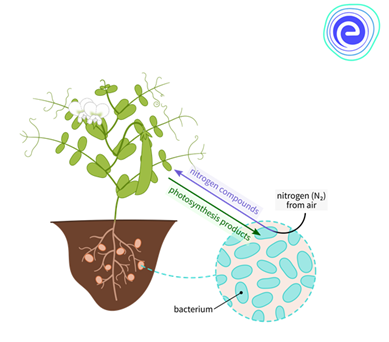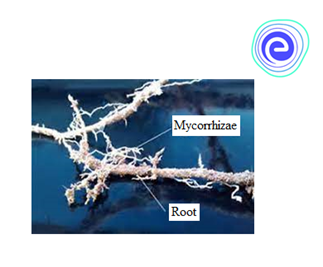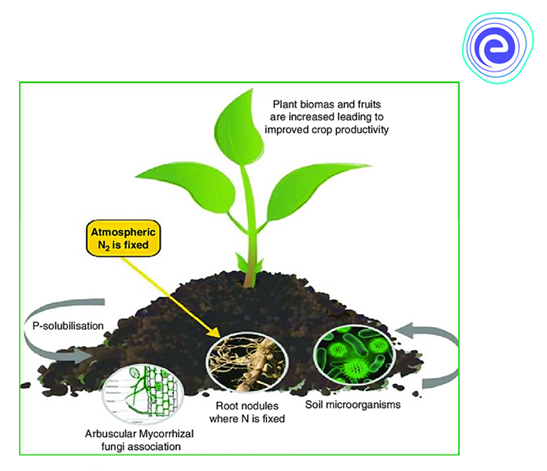Soil Types: Soil is a natural resource broadly defined as the loose top layer of the earth made up of disintegrated rock, humus, inorganic and...

Soil Types: Sandy, Loamy, Clayey and Uses
December 18, 2024
Microbes as Biofertilizers: Biofertilizers are microorganisms that improve soil nutrient quality. Have you ever heard the words fertilizers or manure? Do you understand why we use Microbes as Biofertilizers? Fertilizers are a natural or synthetic blend of several chemicals used to promote soil fertility. However, you should be aware that these chemicals also pollute the environment. What should be done then?
We have started practising organic farming. Organic farming is improving pollutant-crop production. It entails the use of biofertilizers and biopesticides to improve crop nutrient quality and control pests and pathogens. Read on to find out more details on the role of Microbes as Biofertilizers.
Biofertilizers can be defined as living organisms, mainly bacteria, fungus, or algae which increase the supply of essential nutrients in the soil that can be easily used by the host plants promoting plant growth. A biofertilizer organism should be specific strains of microorganisms such as bacteria, fungi, algae or their combinations.
Biofertilizers are classified into different categories based on the types of microorganisms involved:
Bacteria that promote soil fertility may be symbiotic, non-symbiotic (free-living) or occurring in loose association with roots of higher plants. They supplement the soil by fixing nitrogen into nitrogen compounds like ammonia, nitric acid, organic nitrates, etc. For example, Rhizobium, Azospirillum, Azotobacter, Phosphobacteria, etc.
A number of cyanobacteria have the property to fix nitrogen, e.g., Anabaena, Nostoc, Aulosira, etc. Actinomycetes are bacteria known to produce several plant growth-promoting molecules and fight plant diseases by secreting several compounds like secondary metabolites. Hence, these are known to be good for improving agricultural productivity —for example, Frankia.
Trichoderma and mycorrhizal fungi form mutual associations with plants. Fungal biofertilizers play an important role in supporting plant growth, health, productivity and enhancing soil fertility.
Blue-Green Algae (BGA) and Azolla are some algal biofertilizers widely used in organic farming.
Biofertilizers are mostly cultured and multiplied in the laboratory. Hence, we can say that The cultured microorganisms packed in some carrier material for easy application in the field are called biofertilizers. However, blue-green algae and Azolla are organisms that can be mass-multiplied in the field.

Types of microorganisms used as biofertilizers are given below:
Rhizobium
1. Rhizobium is known as the most effective and widely used biofertilizer.
2. Rhizobium, in association with leguminous plants, fixes atmospheric nitrogen in forms that can be used by the plants.
3. Legumes and their symbiotic association with the rhizobium bacteria result in the formation of root nodules that fix atmospheric Nitrogen.
4. Rhizobium population in the soil depends on the presence of legume crops in a field. The population of Rhizobium in the soil diminishes in the absence of legumes.

Fig: Rhizobium
Azospirillum
1. Azospirillum is identified to have a close associative symbiosis with the higher plant system.
2. These bacteria have an association with cereals such as sorghum, maize, pearl millet, finger millet, and many other minor millets and also fodder grasses.
3. These also provide certain antibiotics and growth substances to the plant along with fixing nitrogen.
4. These are not-living as they live inside the plant’s roots, where the atmospheric nitrogen fixation takes place.
5. Azospirillum can be used in wetland conditions as it is likely to be suitable for growth.
6. A pH of \(6.0\) must be maintained in this type of biofertilizer for best results.
Azotobacter
1. These are nitrogen fixers that are-living in nature and are found in a wide variety of upland crops.
2. Besides fixing nitrogen, they also supply antibiotics and growth elements to the plant.
3. Unlike Azospirillum, wetland conditions are unsuitable for these bacterial biofertilizers to survive.
4. Regular application of Azotobacter is required as they contain very minimal fertility.
Blue-Green Algae (BGA)
1. These are photosynthetic, nitrogen-fixing cyanobacteria that can only be found in damp and marshy areas.
2. They are-living in nature and are of many colours like red, brown and sometimes even purple.
3. Blue-green algae are also referred to as rice organisms due to their abundance in the rice field.
4. Most of the nitrogen fixation BGA are filamentous, consisting of a chain of vegetative cells, including specific cells called heterocysts that function as a micronodule for synthesis and nitrogen-fixing machinery.
5. One drawback of using them is that these blue-green algae cannot survive in acidic soil.
Mycorrhiza
There is a symbiotic relationship between fungi and plant roots. They play a significant role in soil binding and microbial activity.

Fig: Mycorrhiza biofertiliser (VAM)
1. Vesicular Arbuscular mycorrhiza (VAM) biofertilizer adheres to plant rhizoids leading to the development of hyphae that cause a significant increase in the rhizosphere.
2. VAM is a unique symbiotic relationship with the roots of the plant and fungi. It can enhance the growth and survivability of plants.
3. VAM biofertilizer is highly beneficial in organic farming and normal commercial farming.
4. Mycorrhizal fungi uptakes minerals from organic matter for the plant.
Phosphate Solubilizing Microorganisms
1. Phosphate solubilizing Microbes (PSM) are useful bacteria that are capable of solubilizing inorganic phosphorus from insoluble compounds.
2. Bacterias like Bacillus, Pseudomonas, and Rhizobium, fungal genera such as Penicillium, Aspergillus, Actinomycetes, and Vesicular-arbuscular mycorrhiza (VAM) are some important PSMs.
3. PSMs promote plant growth by generating phytohormones like auxins, gibberellins, cytokinins, or polyamides and the production of plant growth hormones like IAA and GA.
4. These also help plants to protect themselves from many pathogens by the production of antibiotics, hydrogen cyanide(HCN), and antifungal metabolites.
There are three methods generally used to apply biofertilizers to crops:
Seed treatment: In this method, the seeds are soaked in a mixture rich in nitrogen and phosphorus fertilizers. Later, these seeds are dried in the shade for half an hour and used within \(24\) hours of the treatment.
Soil treatment: Biofertilizers and compost fertilizers are mixed and stored for one night in this treatment. This mixture is then spread on the soil where the seeds will be planted.
Seedling root dip: This technique is generally used for rice crops. The seedlings are planted in a bed of water and allowed to grow for \(8-10\) hours. Azospirillum is commonly used as a seedling root dip, notably for rice.

Fig: Microbes as Biofertilizers
1. Biofertilizers are non-polluting, eco-friendly options that do not cause harm to the environment. They increase the yield of plants by \({\rm{15 – 35\% }}{\rm{.}}\) Hence, biofertilizers are the best replacement for chemical fertilizers.
2. Biofertilizers are inexpensive, effective, and renewable sources of plant nutrients.
3. These convert atmospheric nitrogen to various forms that can be used by plants.
4. Biofertilizers aid in the survival and growth of beneficial organisms.
5. They have the ability to regulate and suppress pathogenic soil bacteria.
6. They produce vitamins and growth-promoting bio-chemicals.
7. Biofertilizers improve soil texture by increasing the quantity of humus in the soil and maintaining or even increasing the fertility of the soil.
8. These promote pollution-techniques of agriculture.
9. Bio-fertilizers are useful and active even under semi-arid conditions.
The use of certain biofertilizers has increased in order to produce healthy and pollutant-agricultural activities. Some of these biofertilizers and their suitable crops are mentioned below:
| Microbes/Biofertiliser | Crop suited | Benefits |
| Rhizobium strains | Legumes such as pulses, groundnuts, soybean, etc. | Nitrogen fixation, increased growth rate, etc. |
| Azospirillum | Non-legumes such as maize, barley, oats, sorghum, millet, sugarcane, rice, etc. | Produces growth-promoting substances and can be applied to legumes as co-inoculant. |
| Azotobacter | Soil treatment for non-legume crops and also certain dryland crops. | Promotes growth and also controls certain diseases. |
| Phosphate Solubilizers | Soil application for all crops. | It helps to produce metabolites that help to increase growth as well as disease resistance. |
| Blue-green algae and Azolla | They are mainly used for rice plants or other wetland plants. | Reduces the alkalinity of the soil, adds organic matter to it and increases its fertility. It can be used as feed for fish apart from promoting hormonal effects for growth. |
| Vesicular Arbuscular Mycorrhiza (VAM) | Several trees, some crops, and a few ornamental plants. | Providing phosphorus present in the soil to the plants, makes the plant inaccessible to the pathogens born in roots and also increase resistance to drought and salinity. |
Frequent use of chemical fertilizers and harmful pesticides has boosted the production of hazardous chemicals that are dangerous for human consumption and also disrupt the ecological balance. Biofertilizers are a safer option to help us solve the problem of feeding a growing global population at a time when agriculture is facing various environmental challenges.
Biofertilizer constitutes living microorganisms which include mycorrhizal fungi, blue-green algae, and bacteria. Biofertilizers are extremely beneficial over chemical fertilizers and do not contribute to pollution.
Here, we have listed some frequently asked questions (FAQs) related to the microbes as biofertilizers:
Q.1. What is the role of microbes as biofertilizers?
Ans: Biofertilizers are microbes that help in nitrogen fixation and thus help in replenishing soil nutrients and act as biofertilizers. Some of these also convert insoluble phosphates to forms that can be used by plants. In addition to growth, the application of biofertilizers also helps to restrict harmful pathogens in soil and crops.
Q.2. What are microbial fertilizers?
Ans: Microorganisms are used to enhance the amount of nutrients uptake by the plants and restore the biodiversity of the soil. Microbial fertilizers can be defined as naturally active microbial inoculants or products that consist of bacteria, algae, fungi or biological compounds which help to benefit the soil and plants.
Q.3. What are biofertilizers? Give biofertilizers examples?
Ans: Biofertilizers are the strains of microorganisms that help in the growth and development of various plants by improving the availability and supply of primary nutrients to the plant. Rhizobium, Blue-Green Algae, Mycorrhiza (VAM), Azotobacter, Azosprillum and Phosphate solubilizing Microbes are some examples of biofertilizers.
Q.4. How do mycorrhizae act as biofertilizers?
Ans: Mycorrhiza biofertilizer (VAM) adheres to plant rhizoids, resulting in the formation of hyphae and a major increase in the rhizosphere. VAM fungi have a unique symbiotic connection with plant roots. It can improve the development and survival of colonized plants.
Q.5. What are the types of biofertilizers?
Ans: 1. Symbiotic Nitrogen-Fixing Bacteria
2. Loose Association of Nitrogen-Fixing Bacteria
3. Symbiotic Nitrogen-Fixing Cyanobacteria
4.-Living Nitrogen-Fixing Bacteria
We hope this detailed article on Microbes as Biofertilizers helps you in your CBSE preparation. If you get stuck do let us know in the comments section below and we will get back to you at the earliest.
Stay tuned to Embibe for the latest updates on CBSE subjects and important topics!